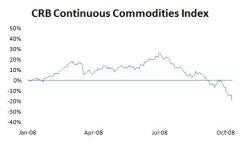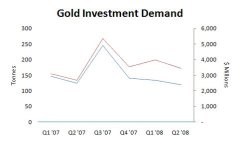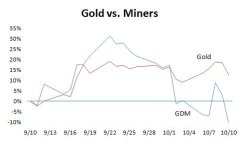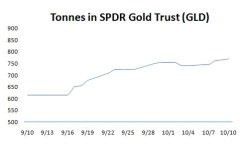What do investors do when the world seems to be ending? Look for safe(r) havens.
- A quick peek at precious metals
- Demand drivers going forward
- The bargain in gold miners
In troubling times, investors search for safe places to put their money. With the latest market plunge making many feel like the mattress is a good alternative, the question on commodity investors’ minds is: Are precious metals still serving their role as a safe(r) haven? Let’s go to the charts.

The story here is a simple one. In the beginning of the year, the gold story was seen by many commodities investors as “played out,” and the focus on the real industrial demand for platinum took center stage – leading to the spike in platinum prices in the first few months of 2008. It didn’t hurt that South African platinum miners were coping with unprecedented power difficulties, shuttering mines and reducing the supply of platinum worldwide.
Silver, which also has an industrial bent, eventually caught up to platinum’s rise in March, before dropping back a bit.
Gold, however, was the laggard. For the first half of 2008, gold limped along like a marathon runner at mile 24, barely squeezing out positive returns through the middle of the year. he reason? The emerging markets/China story is much weaker in gold. Sure, Chinese consumers may buy a little more gold here or there as they join the middle class, but there’s no “omigosh, we’re running out of oil because of surging Chinese industrial demand!”
There is that angle for both platinum and silver.
But then we hit July. And in case you didn’t know it, the world started going to hell in a handbasket. That played out painfully for broad-based commodities investors starting July 1. (Here’s a peek with the same scale, in case you hadn’t looked lately):

As investors realized that all was not ducky with commodities, they rushed back into gold as a store of value. As much as I consider myself a rational person, I’m also not one to fight the market. Despite the fact that there’s no reason that gold should be the thing we place value in, the collective consciousness of the market continues to ascribe value to the yellow stuff.
And this flight back to this agreed-upon de facto currency is what’s obviously behind the recent run-up in gold prices. While the rest of the market stumbled, gold maintained a positive return for the year, at least until Friday, when it managed to throw away its 5% year-to-date win in a fit of convulsive selling.
Where Do We Go From Here?
Let’s look forward. Let’s assume for the moment that the market isn’t headed for an immediate return to low volatility, steady growth any time soon and that consumers remain in a state of too-much-greasy-food nausea for the foreseeable future.
That puts us back in the world of supply and demand – particularly demand.
A Look At Demand
The World Gold Council does a nice job each quarter of illustrating what the demand for gold has been, both in quantity (tons) and dollar amount. The latest report available is for the second quarter, which was released back in August.
Compared with the second quarter of 2007, the amount of gold used in all areas of what GFMS (where the WGC gets its statistics) calls “identifiable demand” went down in Q2’08. (Due to higher gold prices, this drop in consumption did not result in a lower dollar amount spent.) Matching that up against end-of-year information for 2007, here’s what the demand situation looked like for the three metals before all the craziness started:
| Platinum | Silver | Gold | |
| Jewelry | 23.24% | 18.27% | 68.23% |
| Industrial | 69.87% | 76.04% | 11.46% |
| Investment | unknown | 2.88% | 18.66% |
| Other | 6.89% | 2.79% | 1.64% |
Table compiled using 2007 demand information for platinum, silver and gold
What’s interesting is the percentage of gold that goes to investment. While a much larger percentage of gold is used for investment purposes than silver, it is still less than 20%. By far, gold’s most common use is in jewelry. This leaves gold vulnerable to the fickleness of consumer confidence and disposable income. In hard economic times, demand for luxury items is the first to decline.
On the other hand, silver and platinum are used most commonly for industrial uses. We’d expect demand for both to fall in a slowing economy. In both cases, the declines in demand for industry and jewelry are difficult to predict, but common sense would tell us they’ll be lower in a bad economy than a good one.
Gold’s a different story. While it does indeed have to face the potential decline in jewelry sales, we have to wonder how much of that jewelry is really just investment in disguise? In India, gold is commonly bought as jewelry not just because it’s shiny, but because it’s perceived to have lasting value.
And that brings us to investment demand.

That gigantic spike in demand in the third quarter of 2007 was due almost entirely to ETFs putting on gold. And given that ETFs are by far the easiest way to get in and out of gold in a hurry, you’d expect there to be a tremendous demand for them right now. And you’d be right:
In just a month of trading, the actual piles of Atomic Number 79 sitting in the vault at the SPDR Gold Trust rose 25%. That’s a phenomenal amount of gold coming off the street and headed into the vault. And there’s no question that investment demand will be driving the gold bus for the next few months.
Picks And Shovels
As if we didn’t need another example, I can’t look at a commodity without looking at the stocks underneath them…

…and the gold miners continue to underperform the metal. At one point, the AMEX Gold Miners Index (GDM) was down 56% from its March highs. How long this tremendous imbalance of stocks versus the actual gold will last is tough to predict. But with stocks like Freeport-McMoRan (FCX) trading at P/E’s under 5, and with stocks generally cheaper than they’ve been in a generation, how long can the madness last?
In the meantime, I guess it’s time to stick the Krugerrands in the old sock and let the gold bugs have their day. Again.
by Julian Murdoch
SOURCE: finance.yahoo.com




